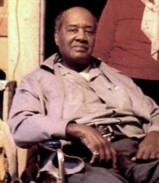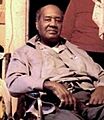Luster Willis facts for kids
Quick facts for kids
Luster Willis
|
|
|---|---|
 |
|
| Born |
Luster Willis
1913 |
| Died | 1991 (aged 77–78) |
| Nationality | American |
| Known for | Painting |
| Movement | Modern Art |
Luster Willis (1913–1991) was a talented African-American artist. He was born in Terry, Mississippi. Luster was well-known for his paintings and drawings. He used many different art styles. He also used a technique called collage. He often used his art to comment on things he saw in the world.
Contents
The Life of Luster Willis
Luster Willis was born on December 25, 1913. He went to school until the eighth grade. After that, he started working full-time on a farm. In spring and summer, he helped his father. They took care of their 60-acre farm. In winter, he cut down trees. He made cross ties for the Illinois Central Railroad.
Luster married Louvennia Bozman on November 10, 1934. They did not have their own children. But they raised two younger cousins together.
In 1943, Luster joined the American army. This was during World War II. He spent three years in Europe. He was in Germany, France, and Austria. This is where he first saw fine art. He left the military in 1947. He went back to Egypt Hill, Mississippi. He then went to Magnolia Trade School. This was in Jackson, Mississippi. He got his barber's license there.
Luster's father passed away in 1963. Luster then took over the family farm. He lived there for the rest of his life. In 1986, he had a sudden stroke. After this, he could no longer create art. He died a few years later in 1991.
Luster Willis's Art Career
Luster Willis showed an interest in art very early. He also had a natural talent for it. However, his teachers did not encourage him. They thought art was not practical or serious. But Luster kept drawing and being creative.
During the Great Depression, he carved walking sticks. He made them for his neighbors in Mississippi. He promised to give a cane to every older person in his town. His canes had single human figures at the top. They were very popular. They became his main way to earn money. He charged between 75 cents and five dollars for each.
When Luster inherited his father's farm in 1963, he had more space. He also had more freedom to create his own way. This is when he started painting and drawing seriously. Soon after, his work was noticed. William Ferris discovered it. He was the director of the Center for the Study of Southern Culture. This center is at the University of Mississippi.
Art Materials and Styles
Luster Willis made his paintings from different papers and materials. He wanted to create a subtle 3D effect. He painted on different kinds of paper. These papers had various thicknesses. Then he glued them together on the same canvas. He called this a "set-in." It was like putting puzzle pieces together.
Willis mostly used watercolors and acrylic paints. He painted on paper, pasteboard, cardboard, and plywood. Sometimes, he added shoe polish. He also used gold or silver glitter. This was for the edges of his "set-in" pieces. It helped to create more depth.
His early carved canes were made from hickory wood. Later, he switched to cedar. Cedar was softer and more flexible.
Throughout his life, Willis made about 300 drawings and paintings. He also made at least as many canes. His paper artworks ranged in size. They were from 9 by 12 inches to 30 inches square.
Inspiration for Art
Willis said he did his best work when he was alone. This was often at night in winter and early spring. During these times, his imagination and the real world could mix. He usually painted in front of his fireplace late at night. This was his art studio.
He covered the walls around him with photos. These were pictures of his family, friends, and community. He looked at them for ideas while painting. These photos helped him focus on certain parts of his art. For example, he paid special attention to eyes. He said, "I work on the eyes a lot, too. I touch them up to try to make them look more human like. Maybe sometimes I overdo it."
Willis's art process was often driven by an image in his mind. But sometimes, it was a free flow of ideas. The idea of death fascinated Willis. This led to many paintings of people in caskets. His first painting about death was about the murder of Emmett Till. As a Black man in Mississippi during the 20th century, Willis saw a lot of death and violence. He saw how it affected his community. He once said, "I think death is interesting. It's something that, sooner or later, we all will have to meet."
Willis painted his own experiences. He also painted his real or imagined community. He used vivid, realistic details. He said, "I draw from life to emphasize it. I speak through a picture what can't be brought into words." His art showed common stories. These stories were found in his community. They were also found in other African American artists' communities in the rural American South.
Art Exhibitions and Collections
Luster Willis's art has been shown in many exhibitions. Some of them include:
- The Afro-American Tradition in Decorative Arts, 1978, Cleveland Museum of Art, Cleveland, OH.
- Made by Hand: Mississippi Folk Art, 1980, Mississippi State Historical Museum, Jackson, MS.
- Black Folk Art in America, 1930-1980, 1982, Corcoran Gallery of Art, Washington D.C..
- What It Is: African-American Folk Art from the Regenia A. Perry Collection, 1982, Anderson Gallery, Virginia Commonwealth University, Richmond, VA.
- Baking in the Sun: Visionary Images from the South, 1987, University Art Museum, University of Southern Louisiana, Lafayette, LA.
- 20th Century American Folk Art from the Arient Family Collection, 1987, Northern Illinois University Gallery, Chicago, IL.
- Gifted Visions: African American Folk Art, 1988, Atrium Gallery, University of Connecticut, Storrs, CT.
- Souls Grown Deep: African-American Vernacular Art of the South, 1996, Michael C. Carlos Museum at City Hall East, Atlanta, GA.
- Stories of Community: Self-Taught Art from the Hill Collection, 2004, Museum of Arts and Sciences, Macon, GA.
Willis's work is also part of the permanent collections in these museums:
- Ackland Art Museum
- The Morgan Library & Museum
- High Museum of Art
- Los Angeles County Museum of Art
- Smithsonian American Art Museum
- Mississippi Museum of Art
- Old Capitol Museum of Mississippi History
- Kentucky Folk Art Center
- St. James Place Folk Art Museum
- New Orleans Museum of Art
- Rockford Art Museum
Images for kids


